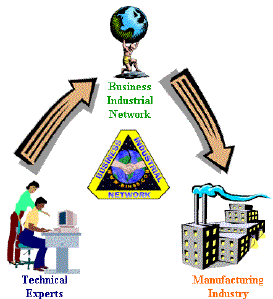The knowledge network, networking people.
The business of networking people and information together.
By Don Fitchett
The myth "We use only 10% of our brains" might not be true, but it is safe to say most of us only use 10% of our people networking resources. A similar phrase also holds true with the "knowledge network" (networking people and information together), "use it - or lose it". Since the beginning of time, man has migrated together sharing ideas and arriving at new ideas as a result of communicating with others.
Of course, the most obvious advantage of networking with your peers and others is that they may have a solution you seek. The more you add to your knowledge network, the better chance you have of finding your solutions and being more successful at what you do. Later I will talk about some of the many resources at your disposal to build your knowledge network.
The most powerful aspect of the knowledge network is often the most overlooked advantage. That advantage is a solution that results when two or more individuals communicating back and forth with a common goal. The result; a solution that would not have been reached by either individual on their own. The power to arrive at that solution and the quality of that solution increase exponentially with each individual who joins the knowledge network!
The value of a network is at least of the order of N-squared
That is Metcalfe's Law (Bob Metcalfe is the inventor of Ethernet), as shown by the example below.
A network of:
- 2 people working on a common problem have 4 times the odds of reaching a solution than each alone.
- 3 sister companies networked together are 9 times more likely to be successful than their competitor's companies who are operating as stand-alone companies.
- 10 web sites networked together is 100 times more powerful than each one alone.
- 4 similar organizations collaborating together will be 16 times more useful to its members than any one individual organization. (Also each will see increased membership proportional to the number of collaborating organizations, squared.)
Okay, I think you get the picture, but I would like to mention just one more point to emphasize the value of the resources available. For instance, take the organization squared example above. One may argue it is not sixteen times say - six hundred in each organization, but actually limited to the number of members you have contact with. One would continue ... in a chapter you actually may only have contact with 10 members, not all 9,600 members.
I would reply, ah-ha! Now I have you thinking! In reality, this may be true, but I would like to bring you into my reality. If only two of those organizations had internet discussion groups and only 5% of the members participated, you could now have two groups of 30. Take another reality check and possibly only 5 individuals from each discussion group would be willing to participate in your discussion. Even that would be equivalent to 25 or more people helping you find a solution.
The key to the above analysis is that the two criteria are being met ...
Individuals communicating back and forth + with a common goal
If you just emailed the 5 individuals in each group and each individual did not have added value of seeing the other individual's replies, you would lose the squared function of the analysis. The result would only be equivalent to 10 people helping you find a solution. Still much more productive than you working on a solution by yourself. The real power of networking comes when all participants share in all the communication. That is when a solution evolves to that which none of the individuals on their own may have ever come up with.
Now when someone asks you; "What is the formula for team work"? You can reply, N-squared. |
 Now a little about the people networking resources available to us all.
Now a little about the people networking resources available to us all.
In the old days, they would walk to the neighbor's farm and share a cup of coffee while brainstorming. Later around the industrial revolution, they would also brainstorm with their peers at work (when the social/political environment would allow it.) Then trade organizations started taking root and small groups would meet for chapter meetings. This was actually a revolution in itself as individuals could start to benefit from sources outside their companies.
Today we have the Internet, email, and discussion boards that serve as much more powerful people networking resources than anyone could have ever imagined back then (well with the exception of a few like Mr. Metcalfe:>). Now we virtually have the entire world with millions of people at our doorstep to network with. With technology evolving so quickly, we need this networking resource to survive in a very competitive world market.
Email: Email has become not only an accepted form of communication and networking but a preferred method. It's quicker than snail mail (postal), you can store all letters on your computer to search and reference later, it saves trees and it's free! Always respond to your email within 24 hours, it's the norm and will increase your chances for success. I actually prefer email to cell phones that have poor reception and lose signals. Email makes for much better quality communication; you always hear what the other is saying, you have and receive more organized thoughts and you don't forget an important detail.
Discussion Boards: The most important of people networking resources via the internet. Many experts are available as well as your peers and they are all free! An example of popular industry-related boards, see PLCTraining.proboards.com/ (Don't forget about LinkedIn too.) Please do not spam them by posting advertisements, but when you help or seek help, be sure and leave your name or company URL as a signature. You want due recognition and it gives the other people you're communicating with, an idea of who you are. Always set up a special email account to use with these boards because unfortunately, the email address you use will receive spam. (Newsgroups also fall under this category and there will be examples on the page referenced above.)
Websites: Many overlook websites and the search engines to find them, as networking tools. When you have a specific issue you need to find a solution for, use Google to search for it. When you find a website specializing in the topic, you have also found an expert. Use the website's contact form and ask for assistance. Most website owners/maintainers will respond within 24 hours. Most will help you out with free advice in hopes of a future relationship.
About the Author: Don Fitchett is President of Business Industrial Network, a company founded on the principles mentioned in this article. (BIN95.com) Please feel free to copy and pass along this article as long as the credits are included.

